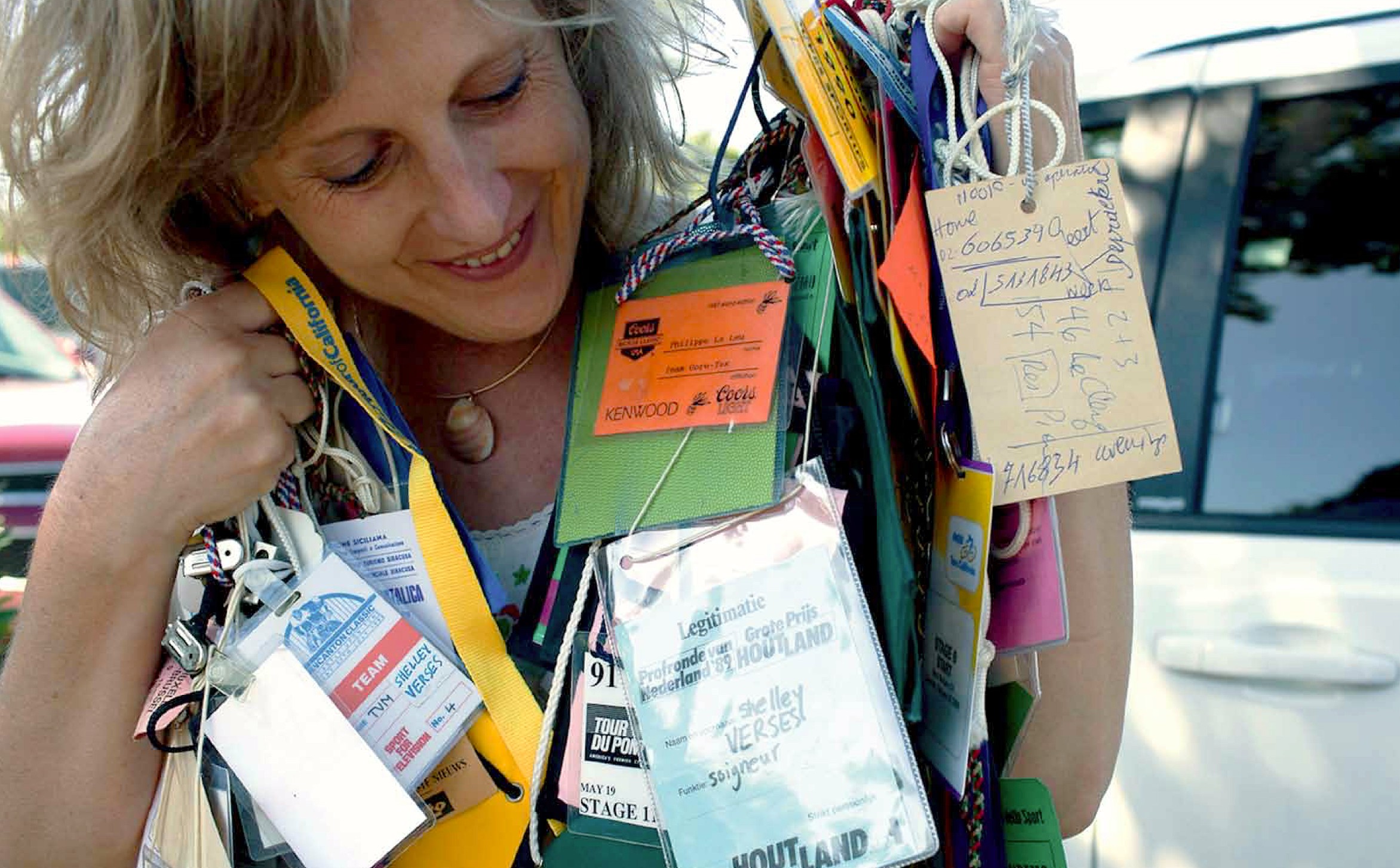We recently ran an interview with Ms. Cherie Pridham, the World Tour’s first female DS but if we go back a few years to the 80’s, who was the first lady to infiltrate the macho world of pro cycling?
Soigneurs; they shouldn’t be too young – they have to have lived a bit; they should be mysterious; surrounded by an aura of camphor and early season changing rooms; of few, gruff words; have hands like shovels; be prone to random sage pronouncements and should never admit that the current pros are as good as they were, ‘back in the day’ – and naturally everyone should be terrified of them.
Blonde, cute, smiling, chatty, cheerful, Californian – and a woman?
‘Mais non! Mon Dieu! Sacre bleu!’
But that was – and is – Ms. Shelley Verses, the first female to break into the closed world of pro cycling as a soigneur with Motorola, La Vie Claire, Toshiba and TVM.
Here’s just a little bit of her story…
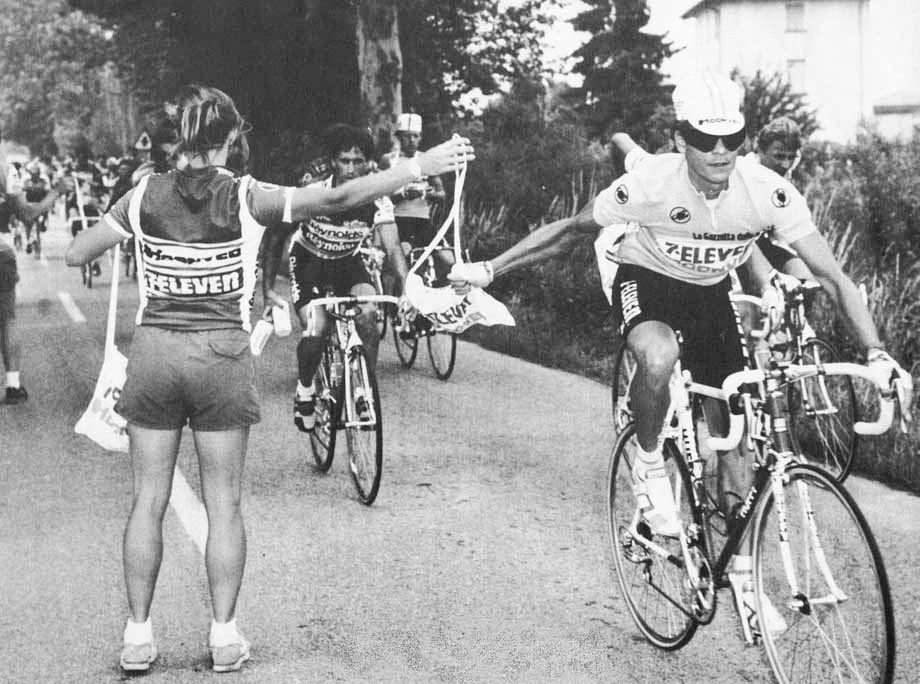
Tell us how you got into the sport of pro cycling, please, Shelley.
“I had a really easy entry.
“I had been working for Eddie Borysewicz the US National Coach at a team camp.
“I was barely 23 years old back in 1983 when I first met him. He had approached me at a race while I was working with the Centurion Cycling Team in Santa Barbara with my boyfriend at the time, Joe Cate who was a local rider on the team.
“We were all at a race in California somewhere and “Eddy B” came up to me. I didn’t know who he was, but this guy in a velour warm-up suit comes up to me with a thick accent and says, ‘I need someone like you at the Olympic Training Center, I see you at races.’
“Eddy B. told me he hand-selected all the soigneurs to work at the U.S. Olympic Training Center (USOTC) and because of Title IX regulations [which forbid discrimination on gender grounds, ed.] he had to hire two female soigneurs.
“He said they usually didn’t last long. They were either sleeping with the riders or they couldn’t handle the load. I asked Eddy how much we would get paid and he said, “You work for free.”
“He was quick to add that I would get free room and board at the USOTC and said if I was good, I could get selected to work big races with the national team and possibly even the 1984 Olympics. I said, “I’ll take the job; when do I start?“
“I wouldn’t have made it through without the help of Amos Ottley. He was an African-American soigneur who had worked for the federation for 25-plus years. He was a very important person at the onset of my career.
“Jim Ochowicz also entered into the picture very quickly;’Och’ was one of the most brilliant people in the cycling world because all those 7-Eleven cyclists were also on the national team.
“I very quickly realized that the other coaches at the Olympic Training Center – Andrzej Bek, Jarek Bek, Roger Young and myself – were also hired to work with the 7-Eleven amateur team. So the 7-Eleven riders in the juniors program, men’s and women’s track program, and men’s and women’s road teams were being taken good care of when they were away from the USOTC and at national team competitions. It paid off the next year at the Olympics when, I believe, six riders from 7-Eleven won medals in Los Angeles.
“Our 7-Eleven phenomena was a focused zone of winning.”
Did you have a mentor?
“At the Olympic Training Center, it was Amos Ottley, who I mentioned above.
“From the first day, I barely had my hands on a rider – the sprinter, Nelson Vails – for a massage when Amos yelled at me from across the room; ‘Hey California! Stop working on him and meet me out in the hallway.’
“He took me out in the hall and told me to listen to him very closely and to copy everything that he was doing, just mimic his every stroke. He said the school I went to did not teach me sports massage and he told me he wanted to make me as good as I could be and to learn everything he knew.
“He said to watch him and learn the rhythm of everything he was doing.
“So that’s how I started my new path of working with cyclists – it was very hard work, 12 to 14 rubs a day.”
The La Vie Claire and Toshiba teams – How did that gig come about, wasn’t it a wrench to leave 7-Eleven and wasn’t it a huge culture shock, American to French mentality?
“After the 1986 season, 7-Eleven had a lot of big changes going on. We had done our first Tour de France that year.
“I got approached at the world championships in Colorado Springs by Paul Koechli, who was the famous director of Bernard Hinault and Greg LeMond. With Bernard Hinault retiring, he wanted to bring about a big change in mentality from the Hinault reign. So I received an unexpected offer.
“I also had an offer to go to the Panasonic team, and I began negotiating between La Vie Claire and 7-Eleven.
“Andy Hampsten had already left 7-Eleven after 1985 and gone over to La Vie Claire. Andy and I were switch-hitting back and forth; he had left and gone to La Vie Claire and was there when LeMond and Hinault were battling it out.
“When Hampsten was done with the French, he went back to 7-Eleven. I left 7-Eleven and went over to the French, leaving my American brothers and going to a place where I didn’t speak the language was a total culture shock.
“I thought Roy Knickman is there, Thurlow Rodgers is there, Steve Bauer is there, Greg LeMond is there – I will be fine!
“Paul Koechli was such a brilliant scientific mind, the first thing he did at the Tour Tour Méditerranéen was to put me with the French entourage… I was put with French Sport Director Maurice Le Guilloux.
“Greg wasn’t there, Steve wasn’t there, Thurlow wasn’t there and Roy wasn’t there. Not one person spoke any English!”
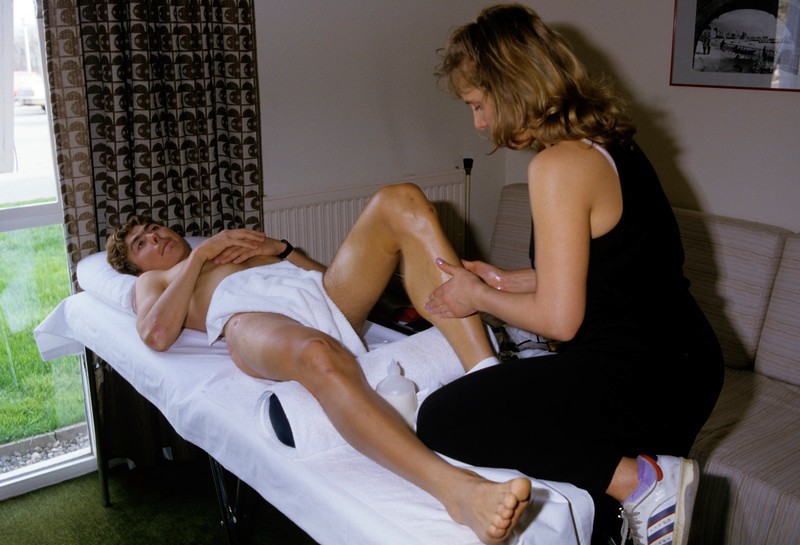
How blatant was the “male only” culture back then?
“I had a taste of it in high school. I played street hockey in a men’s city league. They signed me up as a guy. One day, I screamed when I got checked and slashed…
“They wanted to kick me out of the game because I was a woman.
“But the captain of our team went up to the referee and told him Title IX was already up and going, so if he wanted to be on the front page of the newspaper, to go ahead and kick me out. He said the only foul there, was that I was slashed, not because I was a woman.
“Like I said earlier, I never had problems with the riders, but I certainly had problems right off the bat with one of the soigneurs, Joel Marteill.
“Joel was a wealth of knowledge but he was also the first of many European colleagues who despised me; I was American, I was a woman and I was brought onto the team to make change.
“Paul Koechli wanted me to change the race food of the riders, as well as add variations to their daily regime and I did just that.
“During Tour Méditerranéen, I prepared the start food and the food for both feed zones, only to find our crazed head soigneur, Marteill, driving over the musettes with our 45-foot team semi… back and forth like a madman.
“I remade everything all over again and silently dealt with him until he was canned during the next training camp in Spain.”
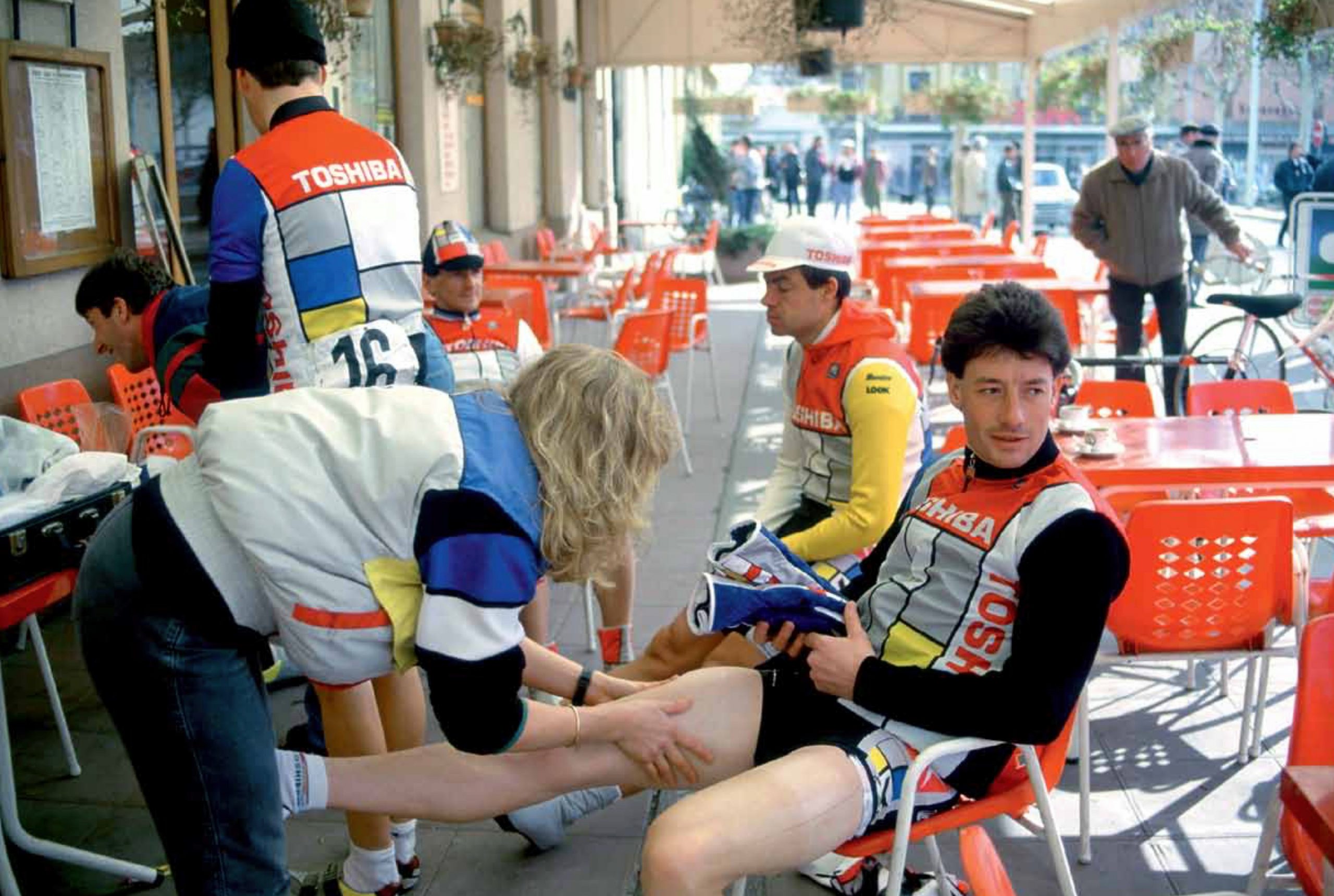
What was Paul Koechli like?
“I adored being on La Vie Claire with Paul. He was a mastermind, a technological trainer. For him, everyone was capable of being a team leader.
“He didn’t hire specialists like sprinters, climbers or time trialists. Whoever was the best in that race was the team leader. He believed that cycling was like a wave… whoever was riding the wave the best was the one who was going to take it to the finish. It was an honour to work on his team.
“He believed in science. He believed in cleanliness. He believed in respect and honor and he also believed that the soigneurs and mechanics and the way we kept our trucks and our team cars was a reflection of the team and our sponsors.
“He had amazing notions. At any moment, he could go to the service course and inventory expiration dates. So you knew you had to keep things current!
“He also had no patience for doping. He had no room for behaviour like that.
“He loved me and did not want me to leave his team. I was always offered a contract back.”
How did TVM come about – French to Dutch mentality, what was that like?
“With La Vie Claire, we had a lot of intensity on that team because Jean-Francois Bernard was supposed to be the next Bernard Hinault; ‘Jeff’ chose me to be his soigneur, so I have a soft spot for him but when I was with La Vie Claire, I always used to have to promise Paul Koechli to never, ever tell Phil [Anderson, her boyfriend who was on rival teams, ed.] if Jean-Francois was not going well.
“So I never told Phil if Jeff wasn’t going well or wasn’t having a good day, I was “sleeping with the enemy,” so to speak, but that was one thing where I never crossed the line. I was so loyal in that one arena because I was so privileged to be where I was.
“Phil Anderson wanted me to take an offer from TVM and go with him so I had to make a choice: Phil or Jean-Francois. I took Phil – and went on another adventure and I finally was on a team with him.
“The mentality at TVM was nearly the same – I wasn’t wanted by the staff, but the riders loved me and everyone loved Phil, of course. I felt at home, especially with the riders, on what was a very mixed, international crew.
“I had a lot of fun with Cees Priem, who was an ex-rider and very close in age to Phil. It was almost like working for a director who was a rider. Patrick Lefevre was the second director and he was really stealthy so that was fun, too. I learned a lot being on that team.”
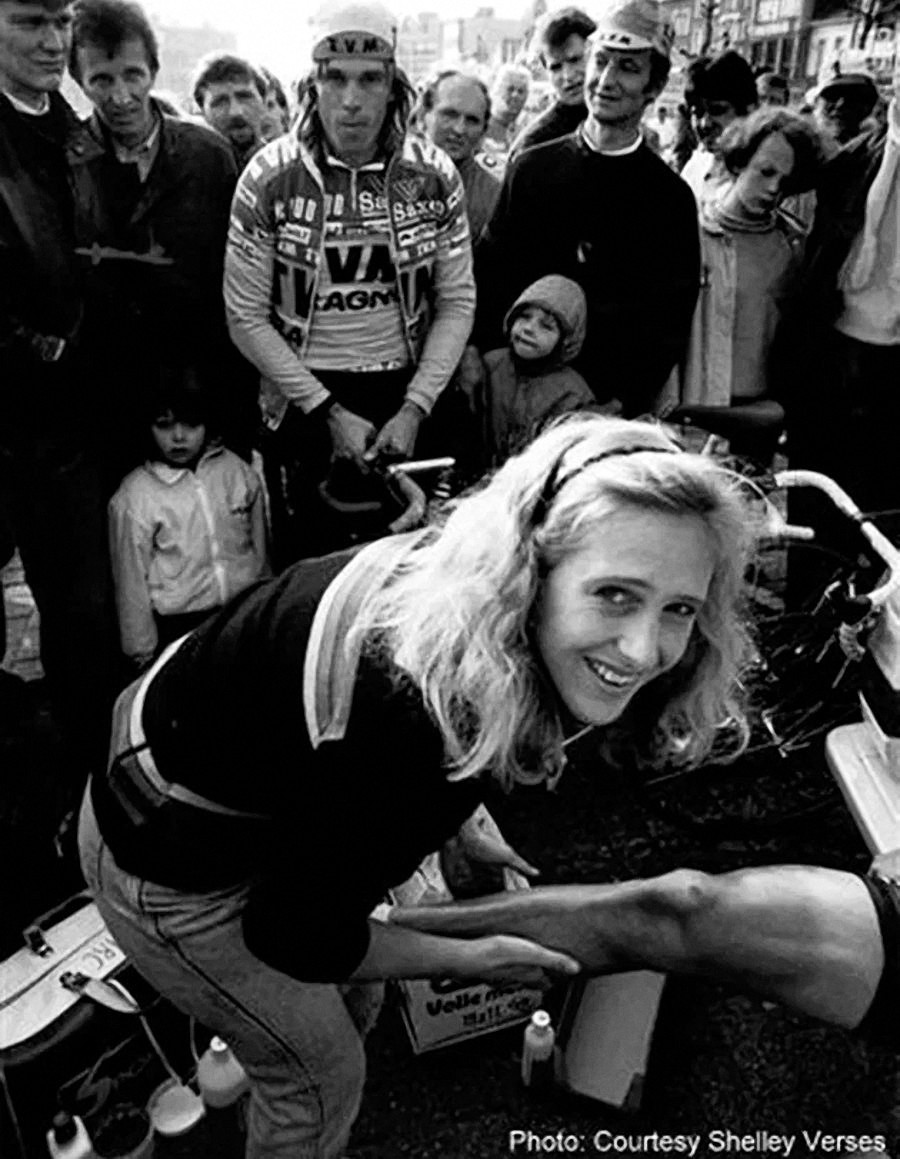
Was it awkward to work with TVM whilst in a relationship with Phil Anderson?
“Phil and I were both so very concerned with our careers. If you look at this relationship nowadays, it wouldn’t be awkward at all.
“If Bradley Wiggins wins the Tour de France and wants to bring his soigneur and mechanic to a new team, it is not an awkward thing. So back then, when Phil Anderson wanted to bring his soigneur with him to a new team, it was only awkward because I was his girlfriend.
“Phil and I had discussed rules; I could not show favouritism toward him on the circuit at all and it actually made more work for me. I’ll give you an example: if he asked me for something to eat – like a sandwich or fruit and yogurt – I had to bring nine sandwiches or nine fruits and yogurt, I had to make one for each rider. The guys loved it!
“Written in my contract was that I always had to room alone. I never shared a room with anyone. That included not sharing a room with a mechanic, a soigneur or even with Phil while I was on the circuit.”
Saturn, back to the US – why?
“I had broken up with Phil Anderson and my feelings were so hurt that I didn’t want to see him so I turned down my contract to go back and work with Paul Koechli.
“Instead, I took a job with Team Saturn which was directed at that time by Warren Gibson. It was a pro team that was racing domestically in the United States and in Mexico. I told them I would not work any race where Phil was because I just did not want to see him.
“After that, for a while, I worked freelance with some other domestic teams. I helped Steve Hegg’s team, ‘Successful Living’, and Chris Carmichael’s ‘CTS’ program. They were both 7-Eleven teammates of mine.
“I also worked with Greg LeMond – one of my teammates on Toshiba – when he took his first LeMond Cycling tour over to Europe in the late 90s.
“That was the last time I saw my European friends over there.”

And you worked with Lance Armstrong for a while, tell us about that.
“One of my 7-Eleven teammates, Mark Gorski, was the director of the U.S. Postal Service team. He asked me to work with one of his riders who had recovered from cancer.
“So I worked with Lance for around a month, I massaged him three or four days a week while he was training, in Santa Barbara with his fiancé, Kristin.”
What was your favorite race to work and why?
“Because I lived near the course, the Tour of Flanders was my favourite race. I was so connected to the roads and the cobbles and the race’s history. The climbs on those narrow roads are just insane! Two riders can barely ride side-by-side up those bergs.
“The type of rider who excels at the Tour of Flanders is one who has to dig so deep.
“But there is also no race like the Tour de France, the largest sporting event in the world. People would camp out for four days in one spot to watch the race go by.
“When we would drive up the Alps – people were chanting the names of riders to the soigneurs driving up the mountain. It was like the parting of the Red Sea, the fans moving to the side so our car could drive through.
“If I could add a piece of the Giro d’Italia into the Tour de France, it’d be to add when the Italian fans chant, ‘Grinta! Grinta! Che Grinta!’ The tifosi would yell this to a sprinter, for example, who would be in the front group of a climb.
“The translation for grinta really means grit but the literal translation in what they are saying to that rider – someone like Guido Bontempo, a big sprinter back in my day – is that they are acknowledging that he is digging down deep inside of himself into his reserve. He is in a place where he normally would not be. They are acknowledging his strength and how strong he is.
“We don’t have an idiomatic expression like that in English, but the meaning is so much more powerful when it’s in Italian. When the passion of an Italian fan is yelling, “grinta.”
“I thought how nice it would have been to see more Italian fans crossing over to France to be a fan at the races there.
“I just love that word, “Grinta” – it’s my favorite word!”
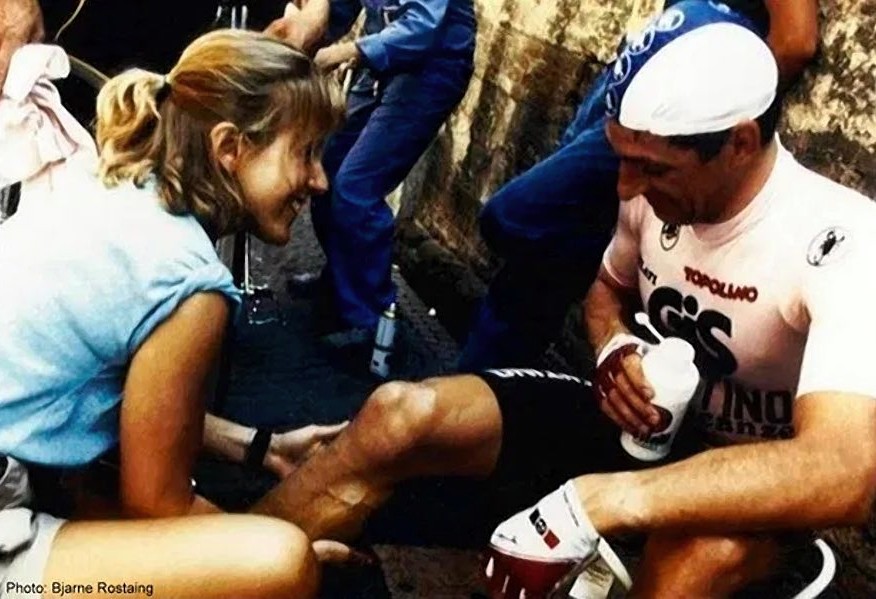
What’s the story about you rubbing Francesco Moser’s legs at the Giro d’Italia?
“In 1985, I was working for 7-Eleven, who made their debut in pro cycling at the Giro d’Italia that year. I was the soigneur (soigneuse?) on the team who went to the hotel every day because female soigneurs were taboo on the European pro tour.
“The prologue in Verona was the only stage that I actually worked at the race itself. We were staying nearby the course and I was supposed to get the food and everything for the stages. Mike Neel, our director sport, wanted me to go to the prologue because our hotel was right there. He thought that would be kind of safe; I would set-up and warm-up the riders.
“The 7-Eleven guys were used to a really different kind of set-up before races in the United States. They were used to lawn chairs and umbrellas and the like. I didn’t have the lawn chairs, but I had camping stools and I stole an umbrella from a café for them. So I was all set up and ready on the pavé of the time trial course by the Coliseum…
“This would be the first time that the press, the teams, and the other riders in Europe saw me.
“The riders were warming up on the cobblestones and Francesco Moser rode by on his time trial bike. He was wearing the pink jersey that he had won for winning the Giro the year before.
“The difference between Moser’s warm-up and all the other riders was that he had a bunch of guys – like mechanics and other helpers – all running after him!
“They had wrenches and tools and even spray for his chain.
“Moser saw me and our guys on these little camping stools under the umbrella and he stopped and approached my little set-up. He sat down on one of the camping stools and I started yelling at him to ‘get out of here!’
“I was used to doing that because we were the real “hot shots” when we racing in the United States.
“Chris Carmichael and Davis Phinney started giving me the stink eye because they knew I didn’t know who this guy was.
“Moser started shaking his legs with that look like ‘Can I get a warm-up?‘ and here I was yelling ‘Get this guy out of here, get him and his crew out of here! Who is this guy?’
“So Moser starts speaking Italian and motioning to his legs to see if he can get a little shake-out. Davis came over and told me ‘You have to work on this guy’s legs – like, now!‘ I told him ‘If I get in trouble, this is on you!‘
“I got my ‘start oil’ and began working on his legs … at least his entourage got a break.
“So that’s the story behind that photo.”
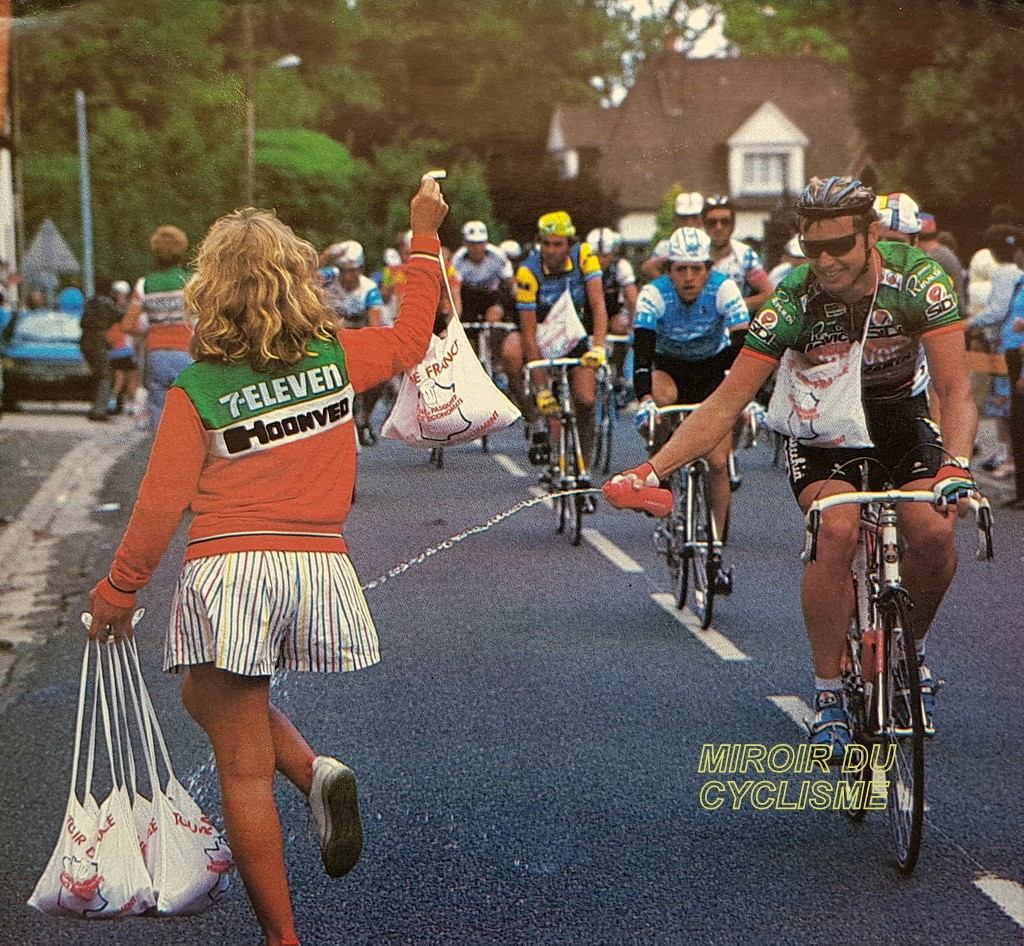
Who had the best legs?
“You know, this is going to make a lot of my riders angry, but the guy everyone on 7-Eleven called “Gomer” – Eric Heiden – had the best legs!
“All four years I was with the team, the soigneurs would fight over who would massage him.
“He was a five-time Olympic gold medallist in speed skating before he was a pro cyclist.
“His left leg was more developed than his right because that was the inside leg that he skated on. His legs were super-supple and toned for their mass. In fact, he was approached one time by a medical textbook company to photograph his legs for their perfect anatomy.
“His legs were ‘beyond the beyond!’”
Who was your favorite rider to work with and why?
“I don’t know if I can answer that question impartially. We would have to write a book! I could tell you stories about so many riders.
“Speaking of my 7-Eleven riders, during our first Tour de France, I ran into problems with the foreign soigneurs on our team. They were angry at the weight of the Americans’ suitcases and duffle bags. They collectively decided that they did not want to catch ‘so-and-so’s’ bag.
“The culprit bags belonged to Eric Heiden, Raul Alcala and Bob Roll. I couldn’t figure out why, so I opened them up. Heiden’s bags were packed with medical textbooks from Stanford. Alcala and Roll’s had full-sized speakers that they hooked up to their Sony Discman.
“To solve the problem, I told the soigneurs that I would carry these three bags for the remainder of the Tour.
“When Raul caught wind of the weight limitation issue, he approached me; ‘Shelley, what about my speakers?’ he asked. I said, ‘Raul, your speakers are fine – music relaxes you.’
“That is a microcosm of my career.
“One of my greatest mentors in cycling was 7-Eleven Sport Director Mike Neel. He taught me how to be calm around the riders and his experience with horses was the reason. ‘Keep the horses quiet in the stable‘, was one of his favourite sayings. He was always teaching me to not let the day’s events have any effect on the riders.
“If I was lost in the Dolomites or involved in some kind of chaos, Mike taught me the art of remaining calm in the eye of the storm and that mindset helps me to this day with my clientele, it’s very Buddhist.”
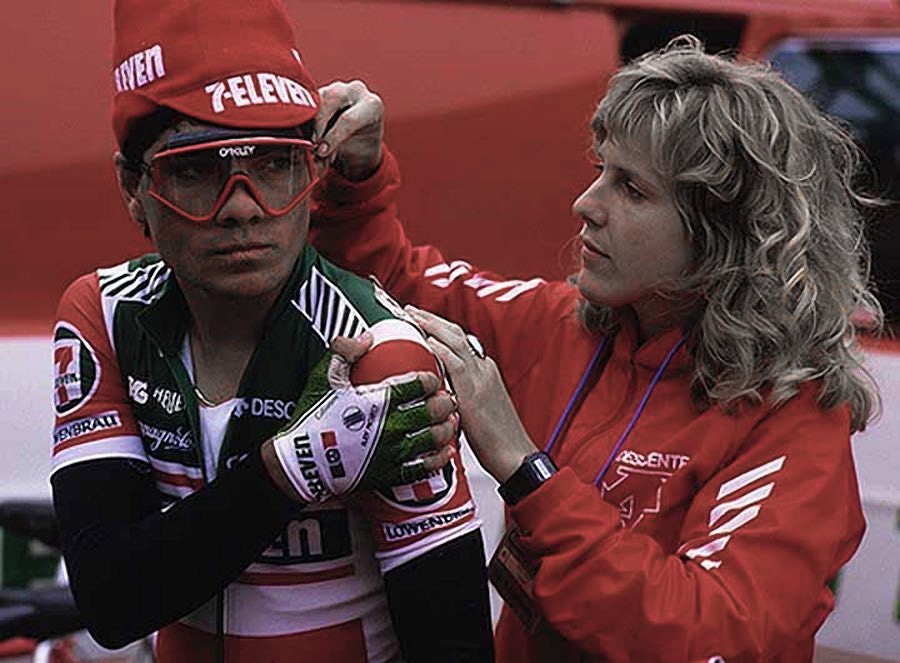
Do you miss being involved in the sport?
“I do. I feel like I worked in the golden era of cycling.
“It was a privilege to have been part of 7-Eleven, to be with Greg LeMond, Phil Anderson, Jean-Francois Bernard… those were people on my team, they were directly in my life, not to mention the riders in my every day walk.
“It filled me up and became so much a part of me.
“I feel like I have a bunch of charms on a bracelet but at times I feel I don’t have the bracelet any more. What I mean by that is I don’t see my teammates and colleagues on a regular basis but the rhythm of the circuit still lives inside of me.
“When I walk through a supermarket in the spring I often have anxiety because I feel I should be buying race food for Ghent-Wevelgem or Liege-Bastogne-Liege!”
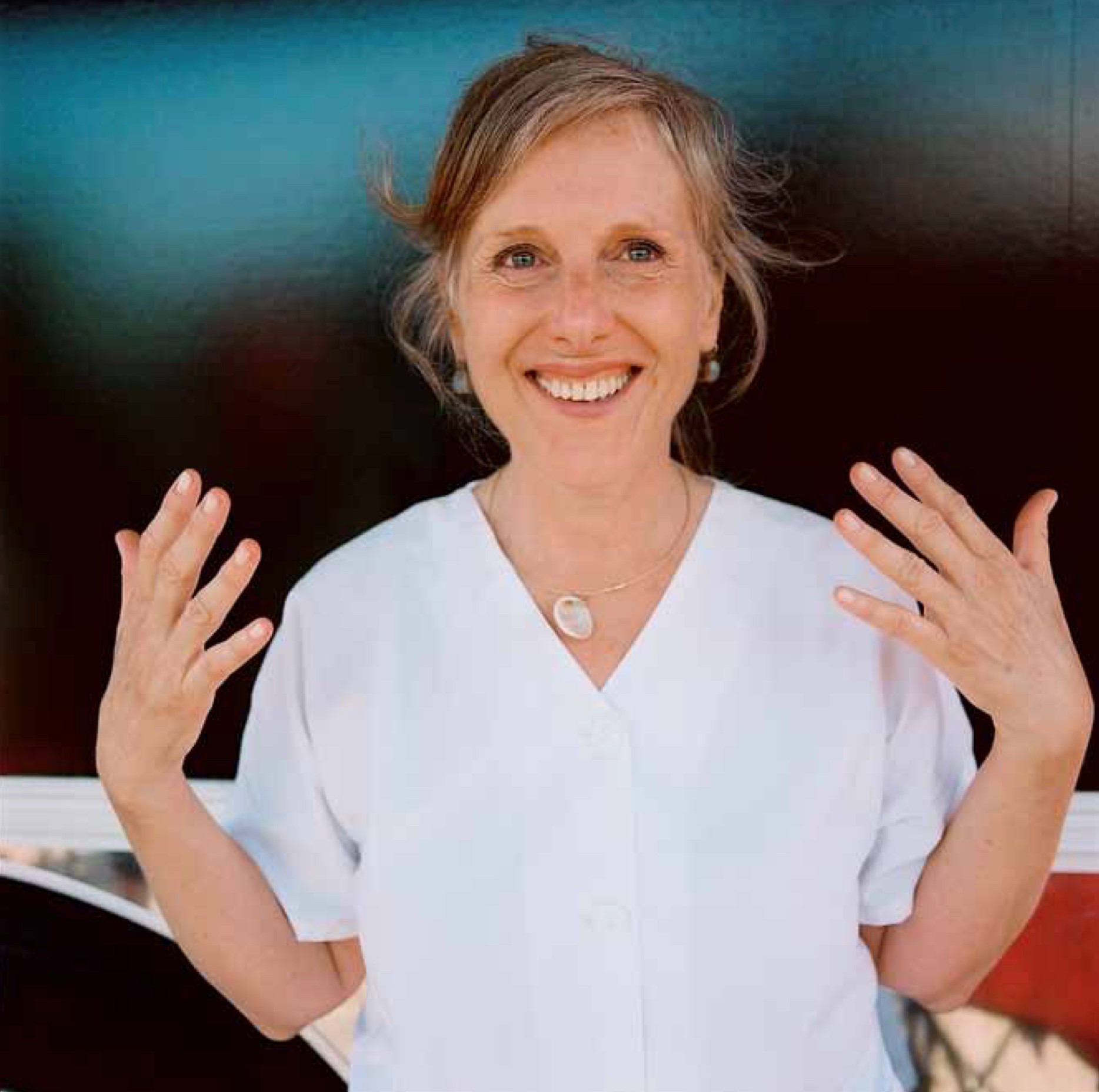
What do you do now?
“I have a massage and health coaching clientele here in Santa Barbara, California. Everything I learned on the pro tour, I apply to my everyday work.
“I am always assessing my client’s bodies the way I would assess a pro rider – I typically don’t massage my clients the way I would a pro. I usually turn down the volume!
“I’m never bored, my clientele is varied. I massage athletes, cancer patients and non-athletes alike.
“In my health coaching practice, I see athletes who want to improve their recovery rate. I see women in peri-menopause and people wanting to improve their health and wellness.
“I coach clients to the right doctors, help them with their supplements and explain the concept and importance of ‘train-race-recover’.”
Do you still follow the sport?
“I do, as best I can.
“I have difficulty remembering all the riders because I am not involved in the sport day-to-day. When I don’t know something or I want to get caught up on things, I call my friend Sean Weide, [sadly, Sean, who was friend of VeloVeritas is no longer with us, ed.] who works in cycling media relations.
I have never felt that Motorola, U.S. Postal Service, Jonathan Vaughters’ teams or BMC Racing have ever felt like a big American team to me like 7-Eleven did, even though they had much more money, so I have never really connected to the American riders the way I did to the 7-Eleven boys.
Bobby Julich, Freddy Rodriguez, Jeff Evanshine, Lance Armstrong and George Hincapie – that group stands out for me. They were great as juniors.
I have always wished there was a true blue U.S. team competing in Europe like 7-Eleven was in the 80s.
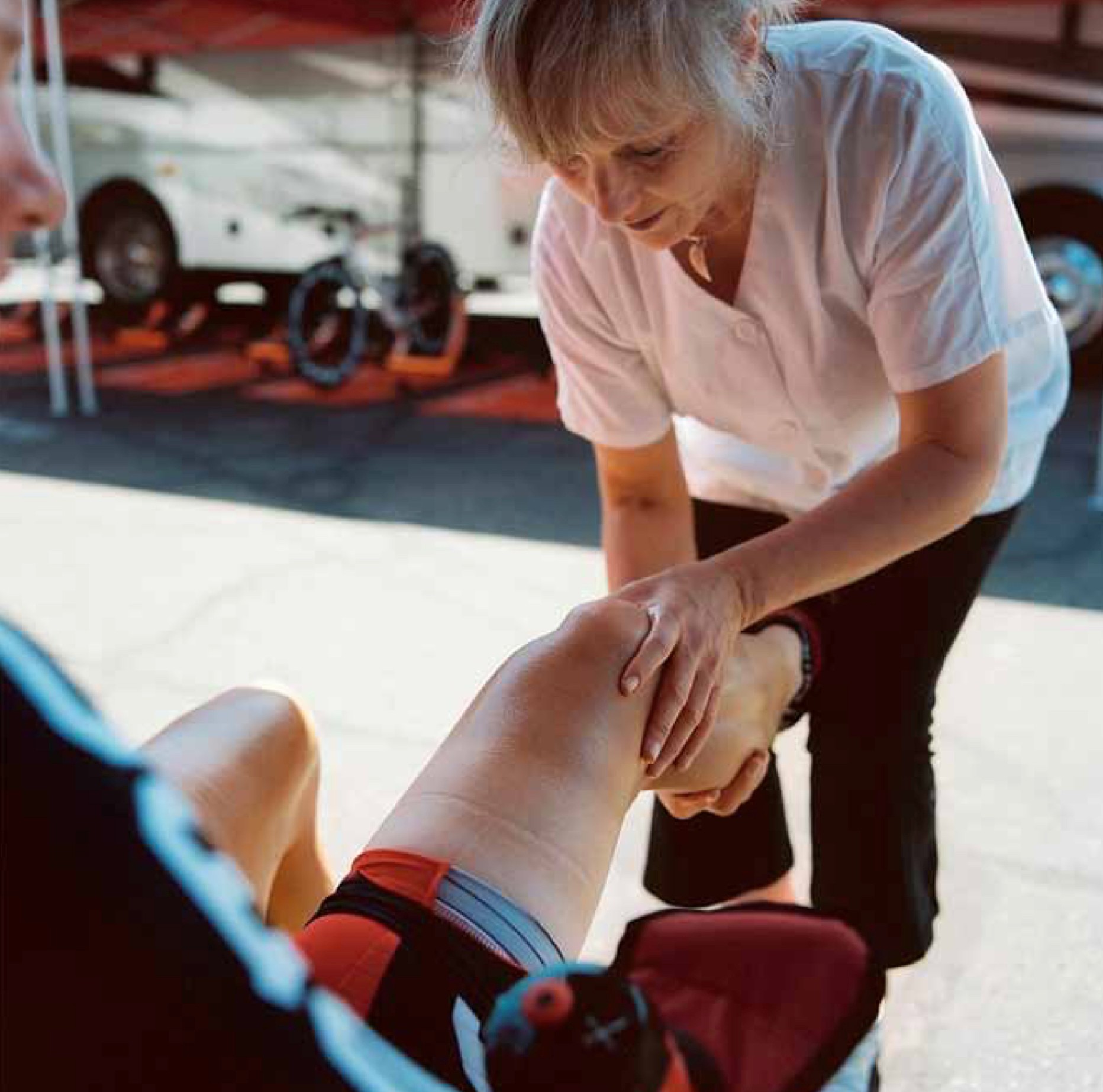
If you could have just one day of your career to re-live, which one would it be?
“That’s a nice question.
“My first thought would be re-live a day for the riders and not for myself. I would want to have Jean-Francois Bernard win the Tour de France he never won, or to have Phil Anderson win the Tour of Flanders he never won.
“Then I realised the question is for me. Ed, I have a meandering answer with a kicker finish!
“I used to love going with the soigneurs during Milano-San Remo to eat pasta. We would all stop between the second and third feeds and have lunch together, all 22 teams, eating together. It was great camaraderie. We were not battling against each other. All 44 soigneurs sat at one big table and shared a meal.
“Then I thought, no, I would want my day to be a stage in the Pyrenees, spent with myself and my Toshiba colleagues, Alain Bizet and Alain Reverdi. We would go to this little tiny mountain restaurant in someone’s house. Everything would be homemade from things in their yard; the chicken, bread, salad, omelettes, herbs and wine. It would only be us in their little house-restaurant in the mountains.
“Then I thought I would rather have it be a regular morning, walking to the start line just one last time. Nowadays, riders are sequestered off in their big buses, fans and journalists aren’t able to have access to them at the starts and the finish line the way it was for me. You can’t touch them or say hi to them.
“On the day that I would want to re-live, I would be walking to the start – like any other day – to get my Coca-Cola water bottles. All the riders would say hello to me and give me kisses: Sean Kelly, Laurent Fignon, Urs Zimmerman, Claudio Chiappucci, Pedro Delgado, Greg LeMond, Phil Anderson, Jean-Francois Bernard, Eddy Planckaert…
“Those boys, those riders, were kings to me. I would be walking through a hall of kings.”
